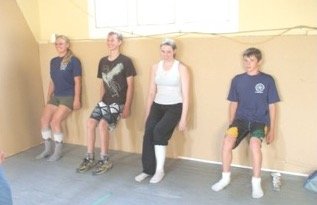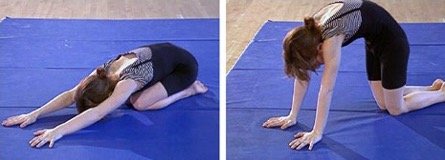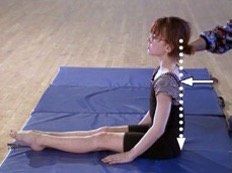Children’s Backpacks: Posture and Health Risks
November, Monday Morning, 7:45 AM: Two Moms and 5 girls, ages 6-9-years (estimated on their height) are passing past the kitchen window, marching down the alley on their way to the neighborhood school. Now in the old times, Moms would have walked and talked to each other as they are neighbors in our cul de sac. But, not now! The two are striding ahead of their children, each with the nose in their phone, hunched over, eagerly flipping to get the newest of whatever morning news trash! On the other hand, the girls hopped merrily along, chatting and laughing, and trying to balance their bodies between skip and hop, their backpacks, and the snow in the alley! Super – except the ‘load’ of these supersize backpacks is forcing the girls into a forward ‘stooped over or slouched’ body position like doing ‘heavy labor!’
So, I examined existing research data on the impact of heavy backpacks on children’s health. I am very cognizant of research studies as an academic whereby positive data usually has numerous counter findings. The same is true for this topic.
PRO: It is common these days to see school children carrying large and heavy school backpacks. Many are so large, in fact, that one can’t help but wonder whether or not these might not only cause back pain but also result in other types of bodily damage, such as scoliosis or other spinal deformities, according to Prof. Emeritus Charoen Chotigavanich, M.D., Orthopedics and Spine surgery, Samitivey Hospital, in Bangkok, Thailand, 2020. He also states that backpacks that are too heavy can cause chronic back pain if carried regularly. Other medical experts report that backpacks have become a common cause in school-age children. Moreover, backpacks do not allow children to stand upright, which leads to shoulder and neck pain.
Furthermore, strained back muscles are evidenced in teens, attributed to strained back muscles, referred to as ‘muscle overuse.’ Although regular exercise is beneficial for all children, intensive training may lead to overuse injuries with back pain in some young athletes. For example, dancers and gymnasts, are especially prone to back pain as are swimmers, training in 3 swim strokes that contribute to forward motion while the back crawl stroke further impacts through the final forward sweep. Specific swim strokes such as the butterfly (back, hips) and breaststroke (knees) are frequently identified as causing pain due to over-training. Given these facts young athletes, who carry heavy backpacks on a daily basis, only intensify their postural problems afflicted through their sport participation. Philosophically, sport is supposed to enhance skills and health but seems to actually produce unfavorable effects. Therefore, coaches ought to implement corrective (remedial exercises) to help counteract such outcomes.
On the other hand, children who are overly sedentary (i.e., don't move much) may have back pain from weak core muscles, back strain from being overweight, or poor posture. Changes in the exercise routine (athletes), carrying or lifting something incorrectly, and of course lengthy periods of sitting or spending time on their tech gadget results in poor posture as well.
In addition to negative effects on posture, carrying heavy backpacks for a longer period of time may cause a certain degree of scoliosis, kyphosis, or other spinal malformations, even though it is not permanent. There are arguments about this among medical experts. According to others, the average school child studies about 8 different subjects in one day. This means they carry at least 8 different school books, notebooks, and worksheets, etc., etc., etc. The impact over time often causes children to encounter back pain, whereby girls are found to experience more pain than boys. However, children frequently develop a forward head posture as the body hinges forward at the hips to balance the body to compensate for the heavy weight on their backs, thus leading to an unnatural postural alignment. Since children do not carry their backpacks for the entire day, however, it does not or only minimally affect their growth, according to some data. While weighty backpacks may cause hunchback or spinal curvature, it should not result in permanent spinal deformities or scoliosis unless the child already had as pre-existing conditions, according to some researchers. If a child does have spinal problems such as scoliosis, and parents are unaware of the condition, carrying a heavy backpack on a daily basis can cause spinal curvature or hunching, that contributes to an already crooked or malformed spine, which may worsen due to the added weight of the bag is the counter argument by some.
In this day and age, children can often be neglected or left to their own devices when it comes to what might appear to be more minor issues, such as this one, but which are, in fact, important matters that need care and attention. Some parents may be entirely unaware of the weight their children carry around in their backpacks each day. When they begin to complain of back pain, they may or may not even realize the cause because they simply did not pay enough attention to the matter at the time or did not notice.
According to experts, the weight of a child’s backpack should be appropriate to the child’s weight and size, and should be no more than 2 kgs for elementary school-age children, weighing 30-40 kgs,. However, many weigh up to 5 kgs, which in the long-term could likely have negative health repercussions. Therefore, it is important that parents become aware of - and look for -alternatives. There is a variation regarding recommendations for children and adolescents carrying schoolbags. Guidelines for safe loads are mostly within 10%–15% of body weight (BW) range but include values as low as 5% and as high as 20%. Some biomechanical studies suggest that the schoolbag weight of 10% of BW may be enough to cause changes in kinematics, body posture, and muscular strain (Mullen, 2018). Other experts argue that heavy school bags are known causes of cervical and lumbar pains. Convincing claims also point out that reduction and shortening of the lumbar spine in proportion to the weight of the school bag will result in overloading and degenerative changes in the spine. Such changes are known causes of back pain in later years.
CON: Based on the study by Perrone, Orr, Hing, Milne & Pope (2018), backpack loads of school students during school days have been suggested to range from 10% to as high as 25% of their body weight, and thus may have a negative impact on their body. The researchers critically appraised existing studies, and extracted and tabulated relevant data prior to a critical analysis. Results: Twenty-one studies were included, ranging in methodological quality from poor to good (critical appraisal scores 22% to 77%). Students carried on average over 15% of their own body weight, which caused biomechanical and physiological adaptations that could increase musculoskeletal injury risk, fatigue, redness, swelling, and discomfort. Conclusion: Considering the limited methodological quality and variations across studies, further research is needed to reveal: (1) the loads students carry around on a school day in their school backpacks and; (2) the biomechanical, physiological, and physical effects of load carriage on students.
What is the Solution?
More studies and especially longitudinal research needs to be carried out to study the negative effects. Backpacks are an ultra-modern commodity designed by a for-profit industry, which most likely never gathered data on potential health afflictions.
Foremost, parents need to educate themselves about current findings and recommendations by medical experts (researchers and pediatricians) regarding the appropriate weight of their child’s/children’s backpacks, which obviously has to be based on their age and body mass/weight. After all, backpacks are a commodity that is sold on the market for profit, not necessarily for good posture!
Educational institutions should consider ways to contribute their share of responsibility by allowing school books to be kept in the classroom, thereby reducing further problems. Foremost, schools at all levels need to re-start physical education and health classes, which have been deleted or severely reduced since the mid-1980s. There has been a great push by Canada for participACTION and physical literacy which has been hyped by the government and federal organizations for years BUT has shown little progress or improved results. Currently, only 37.6% of the targeted groups meet their recommendations while the latest release from participACTION gave Canadian children a D+ grade in their activity and fitness level!
It would be beneficial to educate children on personal health and provide physical fitness classes to secure a quality lifestyle since they already deal with daily stress, anxiety, and depression due to the past and lengthy Covid pandemic. Suicidal attempts and actual death have increased even among younger children! There is no reason, that progressive school principals, responsible for not only the educational process but also for the well-being of children, can not implement physical activities that address postural defects. There are numerous remedial/corrective exercises available that can be carried out in the classroom, the gym floor, or in the hallways. Moreover, there is ample opportunity to use a part of the Annual Teacher Conference Day for posture training sessions by an expert.
Teachers should become more knowledgeable on posture and the impact on learning performance, lifestyle quality, and the physical and mental well-being of their students. As the classical Greeks believed “a sound mind in a sound body!”
Correct Posture – Body Alignment and Performance
Correct posture and proper body alignment are essential not only for personal health and daily quality living but are also critical for academic performance. Poor or faulty posture interferes with skill learning and refinement as it prevents optimizing and maximizing such tasks. Modern lifestyle with the abundance of electronic gadgets (iphones, computers, video games, etc., etc.) has contributed to an increase in children’s ‘slouch’ position. As discussed, children’s heavy backpacks push the body predominantly into a forward direction, causing back, neck, and shoulder pain or at least steady complaints.
Incorrect Posture vs Correct Body Alignment
Examples: Corrective/Remedial Exercises:
Half-squat against Wall – Corrective exercise … can easily be done in the hallway as recess!
Body awareness and control – postural alignment – strengthening body core and lower body (thighs) – static and dynamic balance (stationary and up/down sliding movement against wall) – muscular endurance (holding position)
Line up against wall in half-squat position/heels against baseboard/press head, back, shoulders ‘flush’ against wall/contract buttocks/roll or tilt pelvic slightly forward/hold 15-30 seconds or counts/relax 5 seconds or counts, shaking legs loosely/continue pattern/repeat as needed
Variations–
Assume half-squat position/extend R-leg out in front, parallel to floor/hold 10 seconds or counts/relax, 5 seconds, deep inhale-exhale, shaking legs loosely/continue pattern repeat/repeat as needed/repeat L-leg repeat/L-leg
‘L’-stand with Flat Back-Ball on Back – Corrective exercise
Instead of ball extend arms on top of back
Body awareness andback alignment – core strength – static balance – flexibility
Stand upright/bend upper body forward into ‘L’-position with flat back/ extend arms in back to hold ball on top of back/bum-hip-head alignment/ hold 15 seconds or counts/relax, standing upright, deep inhale-exhale/ continue pattern/repeat as needed
*If balls are not availabe, extend arms on top of back back
Cat/Cow Stretch – Corrective Exercise
Body awareness for ‘rounded back’ posture and control – core strength – arm strength – dynamic balance – flexibility
Assume Heel-sit on floor/rise to big ‘cat’-curl position on all fours (rounded back)/lean forward/using bent arm support, push body low along floor as far as possible, pretending to ‘push a peanut’ with nose/maintain curled back/ after reaching full body extension in front, weight is taken on both arms (push-up position)/hold 10 seconds or counts/return to heel-sit in ‘curl’ position/relax, deep inhale-exhale/continue pattern/repeat as needed
Supine Body Bridge – Corrective exercise
Body awareness and control – core and spine strength (body position – movement to Incline) – strength: hips, thighs, buttocks, calves, ankles, feet – static and dynamic balance – flexibility
Assume supine position on floor (on back)/back ‘flush’ against floor/legs and knees together/bend legs, place feet close to buttocks (ideal 90° angle)/ feet flat on floor/arms extended at sides of body/hands flat on floor, fingers forward (toward feet)/head centered and relaxed/facing forward-upward/use arm and hand support to elevate body/knees to shoulder alignment/hold 5-7 seconds or counts/lower body to floor/relax 5 seconds or counts, deep inhale-exhale/continue pattern/7-10 repetitions or as needed
Variations –
Maintain body flush against floor
Same Exercise: extend R-leg to horizontal/alternate flex-point toes/7-10 repetitions or as needed/relax 5 seconds or counts, deep inhale-exhale/ continue pattern/repeat/L-leg
Same Exercise: extend leg to vertical/continue pattern/7-10 repetitions
Same Exercises: repeat each exercise/alternating legs/10-15 repetitions or set time
Same Exercise: extend R-leg to vertical/bend leg at 90° angle/lower part of leg parallel to floor/close to chest/hold 5-7 counts/lower leg to floor/relax 5 seconds or counts, deep inhale-exhale/continue pattern/7-10 repetitions or as needed/repeat/L-leg
Kneeling Body Incline Backward – Corrective exercise
Body and head awareness (body position and movement) – body balance and control – positional alignment – core strength – static and dynamic balance – quad, thigh, calf, ankle, toe flexibility – muscular endurance
Assume heel-sit on floor/knees together/pointed toes in back/arms extended at sides of body on floor/palms flat on floor, finger forward/back rounded/ head lowered, chin slightly tucked/tighten core/rise to upright kneeling/push pelvis, hips and thighs forward to slowly unravel body to backward incline/ sequence: pelvis, hips, ribcage, head/shoulder to knee alignment/depress shoulders/head centered/maintain positional alignment/hold 7-10 counts/ return slowly to upright kneeling/return hands to sides by body/return to heel-sit/relax 5 seconds or counts, deep inhale-exhale/continue pattern/repeat as needed
L-sit on Floor: Correct Sitting Position–
Current medical research points to the fact that children and society in general is suffering from increased back problems due to faulty or ‘slouchy’ body position. As a result of overuse of tech gadgets, online learning, video games, TV, backpacks, etc. ‘Correct sitting’ can be reinforced by incorporating exercises during Pre-and Post-training phases (20021 term for former Warm-up and Cool-down).
Corrective exercise
Body awareness and alignment – body control – core strength – muscular endurance (hold position) – focus and concentration (sit, close eyes and ‘feel’ correct posture)
Assume upright sitting position on floor/legs extended, pointed toes/arms extended but relaxed at sides by body/hands flat on floor, fingers forward (toward feet!)/head centered/facing forward/partner corrects sitting position, pushing against the back to adjust position (red arrow)/hold7-10 seconds or counts/relax 5 seconds or counts, deep inhale-exhale/continue pattern/repeat as needed/ repeat/switch partners
*Exercise can be performed with back ‘flush’ against the wall while partner assists in maintaining and holding correct sitting position
When assuming the sitting position, hands are flat on floor with fingers facing forward toward feet! – never to the back or sides (common error). This becomes a ‘bad habit’ – when slipping or falling the reaction is to reach behind, resulting in a broken elbow or arm! For this reason, we teach falling and landing in the first unit of gymnastics-type activities.
Improve Your Sitting Posture:
While sitting at the desk at school, working on the computer or studying children need to become aware of their body position and alignment to reduce postural flaws.
Make sure the back is at a right angle to the thighs
Check posture by sitting on the hands
Adjust legs and keep feet flat while sitting
Find a supportive chair to help maintain good posture
Adjust the computer monitor to help with your posture
References:
Brackley H.M., & Stevenson J.M. (2004). Are children’s backpack weight limits enough?: A critical review of the relevant literature. Spine. 2004, 29, 2184-2190. doi:10.1097/ 01.brs.0000141183.20124.a9. PubMed.
Chotigavanich, C. (2020, August 14). The dangers of heavy school bags for children’s backs. Retrieved November 26, 2022, from https://www.samitivejhospitals.com/ article/detail/heavy_school_bag
Drzal-Grabiec J., Truszczynska A., Rykala J., Rachwal M., Snela S.,& Podgorska J. (2015). Effect of asymmetrical backpack load on spinal curvature in school children. Work. 2015, 51: 383–388. doi: 10.3233/WOR-141981. PubMed.
Lasota A. (2014). Schoolbag weight carriage by primary school pupils. Work. 2014,48: 21-26. doi: 10.3233/wor-131614. PubMed
Mackenzie W.G., Sampath J.S., Kruse R.W., & Sheir-Neiss G.J. (2003). Backpacks in children. Clin. Orthop. Relat. Res. 2003, 409: 78–84. doi: 10.1097/01.blo.0000058884. 03274.d9. PubMed.
Monica Tatva Health – PIE (2017, October 29). Heavy school bags: How much weight a child should carry. Retrieved November 26, 2022, from https://www.mtatva. com/en/health/heavy-school-bags-effects-prevention/
Mullen, J. (2018, November 5). Do schoolbags cause low back pain? Swimming Science Blog. Retrieved November 26, 2022, from https://www.swimmingscience.net/do-schoolbags-cause-low-back-pain
Perrone, M., Orr, R., Hing, W., Milne, N., & Pope, R. (2018). The impact of backpack loads on school children: A critical narrative review. Int J Environ Res Public Health. 15(11): 2529. doi: 10.3390/ijerph15112529. Nov 12, 2018. PubMed.gov
Schloder, M.E. (2023). Q.P.P.T: Quality Pre-Post Training for age groups swimmers. Posture and body control exercises.










